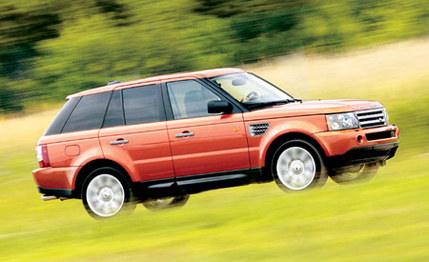 Road Test
Road Test
Sport might be something an Australian calls his buddy at the bar. As in: "G'day, sport, can I get you a beer?" But as used in the acronym SUV, the term doesn't usually apply that well. Most SUVs are just not that sporty, are they? However, in the case of the Land Rover Range Rover Sport, there's an argument to be made for the accuracy of the addendum.
First, just in case you're as confused as we were, let's explain that the Range Rover Sport is a shortened and sharpened Land Rover LR3, brought to market to compete with sportier SUVs such as Porsche's Cayenne and BMW's X5. In the course of reinventing this Sport model from the LR3 platform, the transformation resulted in a vehicle that's about two inches shorter than the LR3 and offers much less interior room. Maximum cargo capacity for the Sport is 71 cubic feet compared with 90 for the LR3, and rear-seat space drops from 55 cubic feet to 49. Despite the smaller size, Land Rover managed to add weight. Our tester pounded the road at a porky 5866 pounds, whereas the last LR3 we tested weighed 5686 pounds.
That could lead some to believe that this would be a slow and clumsy vehicle, but that's not the case. With its generous mass balanced very nearly evenly on the two axles, the Range Rover Sport conducts itself with remarkable poise. It doesn't hurt that the suspension is a combination of adaptive interlinked air springs and active anti-roll bars. Or that the vehicle is shod with 40-series tires on 20-inch wheels, which provide carlike steering response and look like sporty-car tires, despite the vehicle's all-terrain capability.
Add to the remarkable undercarriage the 390-hp supercharged V-8 with its 410 pound-feet of torque, the powerplant normally found under the hood of an XKR or XJR Jaguar, and you can begin to understand why this Range Rover is called Sport. When hooked to a smooth-shifting six-speed automatic (with shift-it-yourself manumatic override), the V-8 powers the Rover around with ease, a restrained burble its only comment. Then stand on it hard, and the big Sport rushes forward with surprising determination, running to 60 mph in just 6.7 seconds. You can hear the supercharger's wail during hard acceleration, but even then it isn't intrusive.
In fact, all noise has been effectively suppressed in the Sport. Wind noise is well down on what one might expect from such a tall and square vehicle, and the Continental 4x4 SportContact tires, with their streetlike tread pattern, clearly do their bit to keep the 70-mph-cruising noise level down at 67 decibels.
All of which is in character with the car's interior. Although based on the LR3 cockpit, the supercharged Sport wears enough premium leather and cherry wood to provide a decent compromise between utility and luxury. Metal-tone plastic accents on the door handles and alongside the center console are echoed on the steering wheel, and if the overall effect isn't quite as plush as in the Range Rover proper, well, the supercharged Sport is also less expensive by about five grand.
The seats are firm and supportive, and the driving position is natural, with none of the bus-driver posture found in older Range Rovers. That expected SUV high vantage point is there, but the excellent body-motion control afforded by the Dynamic Response system—it automatically alters damping and roll-control rates according to how the car is being driven—minimizes any tipsy sensations.
To check out its sport credentials, we drove the Range Rover Sport in the mountains near Malibu, California, and were pleasantly surprised at how well this vehicle takes to the tortuous ribbons of asphalt that traverse this area. Again, thanks to the mechanisms that discourage unwanted body motions, the vehicle avoids any rolling and wallowing during hard cornering.
The brakes—four-piston Brembos on the front end—rein in the Range Rover with plenty of power and feel. Then you can swing the nose with the smooth ZF Servotronic steering gear, which is accurate and nicely weighted if not particularly communicative. As the vehicle reaches the corner apex, you then exploit the abundant torque of the supercharged V-8 and the all-wheel-drive system to pull the vehicle out of the corner without tire scrub.
As long as the cautious stability-control system has been disabled, a driver can get on the power early and stay on a tight arc that avoids crossing over the center line. Range Rover engineers claim they could have dialed body roll right out of the equation but refrained from doing so to provide some of the cornering feedback most people expect.